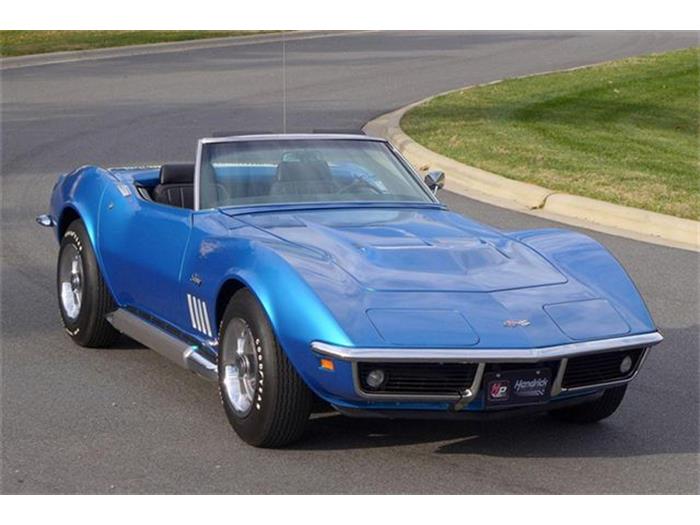The third generation Chevrolet Corvette (or C3, built from 1968 to 1982) went through many changes and technological advances during the 15 years of production. Even though the USA, and the rest of the world for that matter, was experiencing the first real fuel shortage crisis and facing continually restrictive EPA regulations throughout the entire series, the sales of the first true American Sportscar continued to increase by huge numbers.
Find a classic Studebaker that you love!
See all third generation Chevrolet Corvettes for sale
Browse the world’s largest online marketplace for classic and collector vehicles.
The C3 series was a toned-down version of the popular Mako Shark II concept vehicle,easily one of the most famous and recognizable concept/show cars of all time (designed by Bill Mitchell and his team at Chevrolet, including the young Larry Shinoda). The Mako Shark II, concept/show car, was first shown at the Motorama show in 1965 to rave reviews and was a newer version of the Mako Shark I from 1957. The “Stingray” fender scripts were used from 1969 through 1976. Even though everyone referred to all 1963 through 1982 Corvettes as Stingrays, the scripts were absent from all 1968 units and from 1977-1982.
There were two body styles of the newly-designed C3 Chevrolet Corvette, which included a convertible model with a hinged hard cover to conceal the top when in the down position and the T-Top model, which was the first dual-panel, removable roof design to debut in the U.S. marketplace. In fact, the T-Top model proved to be so popular, that the convertible models were discontinued altogether after the 1975 production year and would not return until 1986. The T-Top design was unique, and actually became a secondary design choice, mainly due to the creaks and groans (due to body-flex) produced by the initially designed, single-panel removable roof ( a design flaw the engineers could not seem to quiet). The chassis and engine offerings remained unchanged from the previous C2 series Corvettes and horsepower only diminished over the years, mainly due to strict EPA restrictions. The Big-Block engines were discontinued after 1974.
Of course, the usual upgrades to creature comforts (including leather seats and “cockpit” styled dashboard) and the technological advancements were continuously made over the years through the end of C3 production. The Corvette went through a period of metamorphosis from raw-powered, street and racetrack monster to more of a mild, yet sexy, boulevard cruiser. The horsepower rating of the final year (1982) of the C3 production run was a mere 200 hp. This meager horsepower rating actually increased over the previous years 190 hp rating. This was only due to the introduction of the first fuel injected (Chevrolet’s, Cross-Fire, electronic throttle-body system) Corvette since 1965. Keeping in mind, that in 1972 General Motors (and most other automobile manufacturers), changed to the SAE “Net” horsepower rating system, as opposed to the previously used SAE “Gross” horsepower rating system (270 hp gross = approximately 200 hp net). This resulted in lower, but more realistic horsepower ratings. This horsepower rating system is still in use today, as a global standard.
Some other highlights during the C3 production run, were the introduction of rubberized front and rear bumpers after the 1973 model (which actually had the new “rubber” nose, but retained the chrome rear bumperettes) to meet government safety standards for slow speed impact. There was also the addition of catalytic converters incorporated into all exhaust systems starting in 1975 which marked the end of a true dual exhaust system as we know it (thus,1974 was last year for true dual exhaust systems). This required the installation of steel floorboards, to replace the previous fiberglass units, due to the higher heat created by the catalytic converters. In 1978, the Corvette fastback styling returned, with an elongated, unopenable, rear glass area which included a larger storage area in the rear deck. The 1980 Corvettes, lighter in weight, introduced a more aerodynamically advanced body design which reduced wind drag and improved performance. In mid-year of 1981 the new Corvette specific production facility was finally ready, and all Corvette production was moved to Bowling Green, Kentucky where it remains to this day.
Zora Arkus-Duntov, also known as the “Father of the Corvette”, officially retired in 1975 and was replaced by Dave McLellan as Corvette’s Chief Engineer. However, Mr. Duntov would always be “unofficially” involved with the Corvette until his death in 1996. He remains the most influential figure of the first true American Sportscar in history. His unwavering input and support over the years, resulted in creating and refining the American icon that is the Chevrolet Corvette.
Find a classic Chevrolet Corvette that you love!





